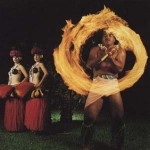Foods Inspired by The Luau
 The sweet smell of orchid tickles your nose as you feel the rhythm of the drums in your chest. You bow your head to accept your lei and follow the intense thumping to a large clearing, finding your place among the floor mats and towering constructions of native flowers and ferns. The savory smell of roasted pulled pork beckons you to the buffet and then as you take your seat, the hula dancers take the stage.
The sweet smell of orchid tickles your nose as you feel the rhythm of the drums in your chest. You bow your head to accept your lei and follow the intense thumping to a large clearing, finding your place among the floor mats and towering constructions of native flowers and ferns. The savory smell of roasted pulled pork beckons you to the buffet and then as you take your seat, the hula dancers take the stage.
The luau is one of Hawaii’s most famous traditions and the focus of this week’s columns. Modern, commercially thrown celebrations are extravagant and offered at various hotels every day of the week, but locals save them for special occasions. The most common reason for a native Hawaiian to throw a luau is a child’s first birthday or a high school graduation. And while the event that seems to be a staple of Hawaiian culture, it has not always been this way.
The Inception
Prior to 1819, Hawaiian men and women ate meals separately. Their ancient religion required that only men of high ranking could eat certain delicacies and thus the comingling was forbidden. Then King Kamehameha II changed all that. He abolished the archaic practices and broke religious taboos by beginning a new tradition, the luau, where the king and women ate together.
Everyone sat on the floor on Lauhala mats around elaborate centerpieces made of local flowers and ferns. They ate poi, a Hawaiian staple made from mashed taro root, lu’au, the baked dish of chicken, taro plant leaves and coconut milk for which the celebration was named, other meats, fish and sweet potatoes. Food was piled high on clean ti leaves and they used their fingers gusto.
As time went on, the feasts became increasingly lavish and eventually introduced roasted pig and entertainment in the form of Hula and Polynesian Fire Knife Dancing.
At one of the largest luaus, held in the mid-19th century for King Kamehameha III, guests were treated to over 270 roasted pigs, almost 5,000 salted and fresh fish, over 2,000 coconuts and 480 bowls of poi.
The Modern Luau
While the modern luau is not as extravagant an event as it was in the 1800’s, it is still a grand affair offering visitors a chance to enjoy traditional foods as well as hula and Polynesian dance. In many cases people still sit on the floor on Lauhala mats and eat with their hands, although flatware is usually available.
The luau celebration begins with shell lei as participants are ushered into the oceanfront gardens to enjoy Polynesian arts and crafts, and to witness the unearthing of the roasted pig during the Imu ceremony. The extensive buffet includes such delicacies as Kailua pork, poi, salmon and ahi poki, and once guests have filled their plates, they are encouraged to eat and enjoy the show.
Despite the commercial productions, food is the centerpiece of every luau. This week we will bring you traditional recipes, explain the cooking methods and history behind each one, and we will give you tips on how to create an authentic celebration at home.
Until next time, Aloha oukou.










